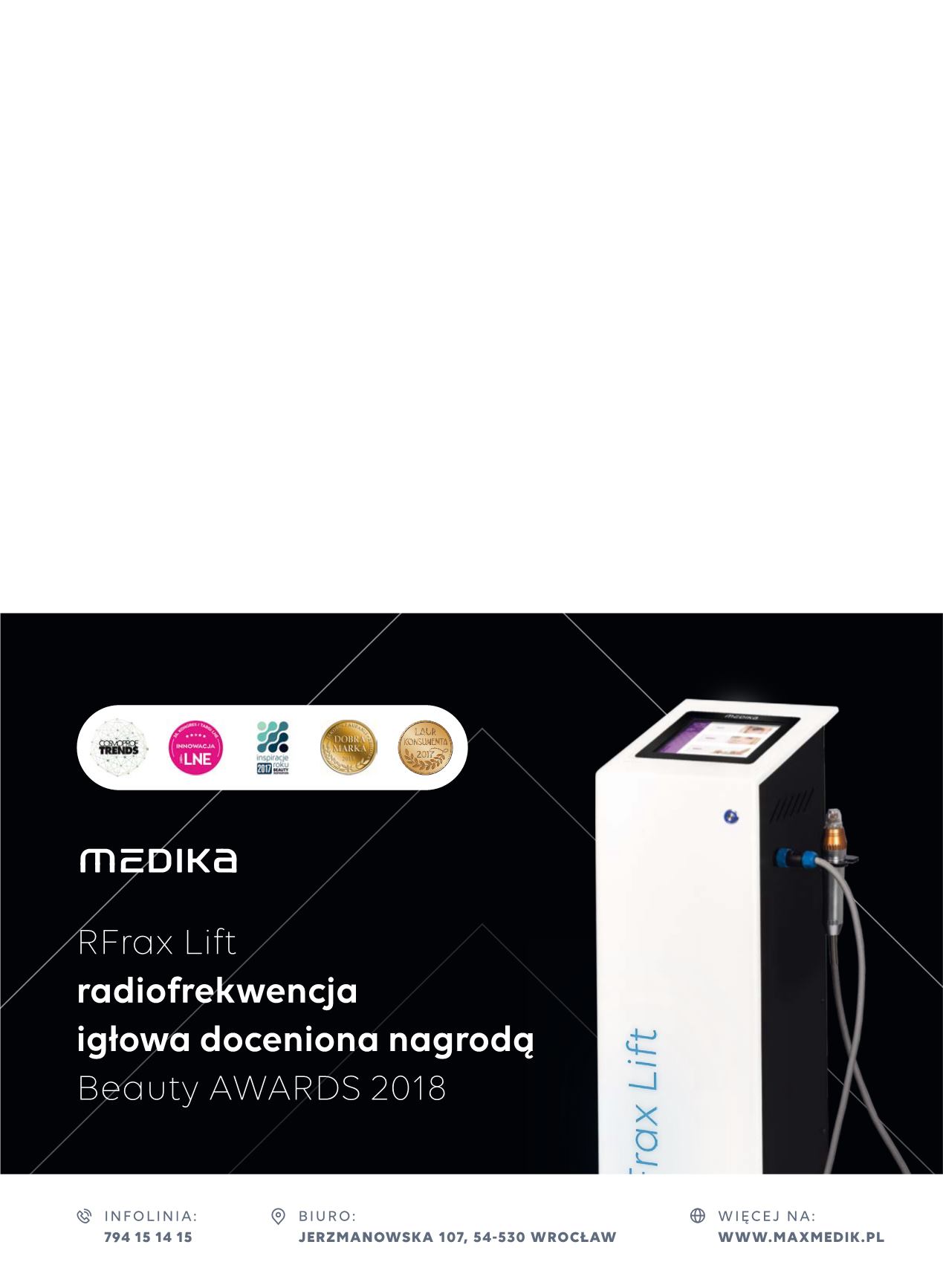
6 / 2018 / vol. 7
Kosmetologia Estetyczna
700
artykuł naukowy
Kosmetologia Estetyczna
N
do wykonania zabiegów w określonych wskazaniach i w okre-
ślonych okolicach ciała. Potrzebne są zatem dalsze badania
oraz wnioski z obserwacji wyników pod kątem doboru para-
metrów zabiegowych.
LITERATURA
1.
Burton JL, Cunliffe WJ, Stafford I, Shuster S. The prevalence of acne vulgaris in
adolescence. Br J Dermatol. 1971, vol. 85(2): 119-126.
2.
Munro-Ashman D. Acne Vulgaris in a Public School. Trans St Johns Hosp Dermatol
Soc. 1963, vol. 49: 144-148.
3.
Rademaker M, Garioch JJ, Simpson NB. Acne in schoolchildren: no longer a concern
for dermatologists. BMJ. 1989, vol. 298(6682): 1217-1219.
4.
Cunliffe WJ, Gould DJ. Prevalence of facial acne vulgaris in late adolescence and in
adults. Br Med J. 1979, vol. 1(6171): 1109-1110.
5.
Ghodsi SZ, Orawa H, Zouboulis CC. Prevalence, severity, and severity risk factors
of acne in high school pupils: a community-based study. Journal of Investigative
Dermatology. 2009, vol. 129(9): 2136-2141.
6.
Williams C, Layton AM. Persistent acne in women: implications for the patient and
for therapy. American Journal of Clinical Dermatology. 2006, vol. 7(5): 281–290.
7.
Capitanio B, Sinagra JL, Bordignon V, Fei PC, Picardo M, Zouboulis CC. Underesti-
mated clinical features of postadolescent acne. Journal of the American Academy
of Dermatology. 2010, vol. 63(5): 782-788.
8.
Cotterill JA, Cunliffe WJ. Suicide in dermatological patients. Br J Dermatol. 1997,
vol. 137(2): 246-250.
9.
Goodman GJ. Postacne scarring: a review of its pathophysiology and treatment.
Dermatol Surg. 2000, vol. 26(9): 857-871.
10.
Layton AM, Henderson CA, Cunliffe WJ. A clinical evaluation of acne scarring and
its incidence. Clin Exp Dermatol. 1994, vol. 19(4): 303-308.
11.
Goodman GJ. Management of post-acne scarring. What are the options for treat-
ment? Am J Clin Dermatol. 2000, vol. 1(1): 3-17.
12.
Gan S., Graber E. Papular Scars: An Addition to the Acne Scar Classification Scheme.
J Clin Aesthet Dermatol. 2015, vol. 8(1): 19-20.
13.
Jacob CI, Dover JS, Kaminer MS. Acne scarring: a classification system and review
of treatment options. J Am Acad Dermatol. 2001, vol. 45(1): 109-117.
14.
Fabbrocini G, Annunziata MC, D’Arco V, et al. Acne scars: pathogenesis, classifica-
tion and treatment. Dermatol Res Pract. 2010: 893080.
15.
Jacob CI, Dover JS, Kaminer MS. Acne scarring: a classification system and review
of treatment options. J Am Acad Dermatol. 2001, vol. 45(1): 109-117.
16.
Tierney EP, Kouba DJ, Hanke CW. Review of fractional photothermolysis: treatment
indications and efficacy. Dermatol Surg. 2009, vol. 35(10): 1445-1461.
17.
Goodman G. Post acne scarring: a review. J Cosmet Laser Ther. 2003, vol. 5(2): 77-95.
18.
Doddaballapur S. Microneedling with dermaroller. J Cutan Aesthet Surg. 2009,
vol. 2(2): 110-111.
19.
Dogra S, Yadav S, Sarangal R. Microneedling for acne scars in Asian skin type: an
effective low cost treatment modality. J Cosmet Dermatol. 2014, vol. 13(3): 180-187.
20.
Alexiades-Armenakas MR, Dover JS, Arndt KA. The spectrum of laser skin resur-
facing: nonablative, fractional, and ablative laser resurfacing. J Am Acad Dermatol.
2008, vol. 58(5): 719-737.
21.
Zelickson BD, et al. Histological and ultrastructural evaluation of the effects of
a radiofrequency-based nonablative dermal remodeling device: A pilot study. Arch
Dermatol 2004, vol. 140(2): 204-209.
22.
Dierickx CC. The role of deep heating for noninvasive skin rejuvenation. Laser Surg
Med 2006, vol. 38(9): 799-807.
23.
Lolis MS, Goldberg DJ. Radiofrequency in cosmetic dermatology: a review. Dermatol
Surg. 2012, vol. 38(11): 1765-1776.
24.
Hruza G, Taub AF, Collier SL, Mulholland SR. Skin rejuvenation and wrinkle reduction
using a fractional radiofrequency system. J Drugs Dermatol. 2009, vol. 8(3): 259-265.
25.
Kasprzak W, Mańkowska A.: Fizjoterapia w kosmetologii i medycynie estetycznej.
Wyd. PZWL, Warszawa 2010: 112-119.
26.
Wollina U. Treatment of facial skin laxity by a new monopolar radiofrequency de-
vice. J Cutan Aesthet Surg. 2011, vol. 4(1): 7-11.
27.
Seung Jae L, Un-Cheol Y, Seong Ho W, Jae Hong S, Kee-Young R, Ee Seok L, Chun
Pill Ch, Suk Bae S, Geun-Soo L, Tae-Heung K, Won-Serk K. Consensus Recommen-
dations on the Use of a Fractional Radiofrequency Microneedle and Its Applications
in Dermatologic Laser Surgery. Med Laser 2014, vol. 3(1): 5-10.
28.
Hantash BM, Ubeid AA, Chang H, Kafi R, Renton B. Bipolar fractional radiofre-
quency treatment induces neoelastogenesis and neocollagenesis. Lasers Surg Med.
2009, vol. 41(1): 1-9.
29.
Omi T, Sato S, Kaminaka C, Yamamoto Y, Kawana S, et al. A Histological Study on
the Treatment of Acne Scars with Fractional Radiofrequency: Preliminary Findings.
J Clin Exp Dermatol Res. 2014, vol. 5(1): 203.
30.
Cho SI, Chung BY, Choi MG, Baek JH, Cho HJ, Park CW, et al. Evaluation of the
clinical efficacy of fractional radiofrequency microneedle treatment in acne scars
and large facial pores. Dermatol Surg 2012, vol. 38: 1017-1024.
ŹRÓDŁA FOTOGRAFII I RYSUNKÓW
I.
Gan S., Graber E. Papular Scars: An Addition to the Acne Scar Classification Scheme.
J Clin Aesthet Dermatol. 2015, vol. 8(1): 19-20.
II.
Archiwum własne autora.


